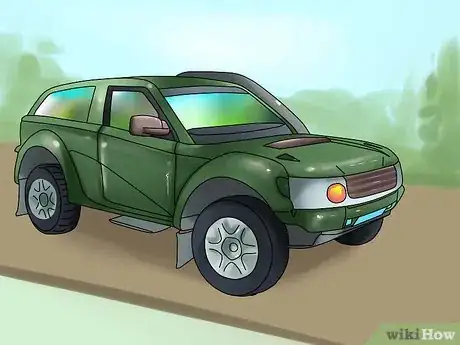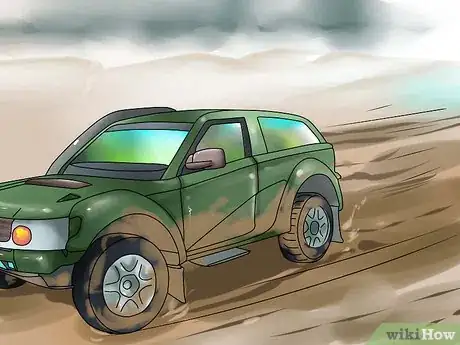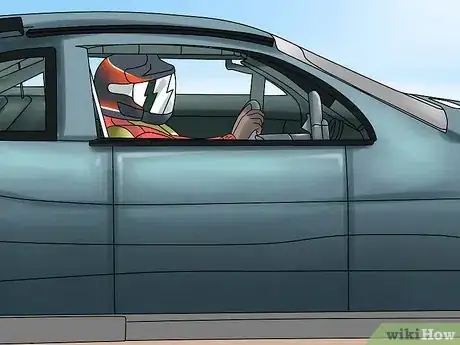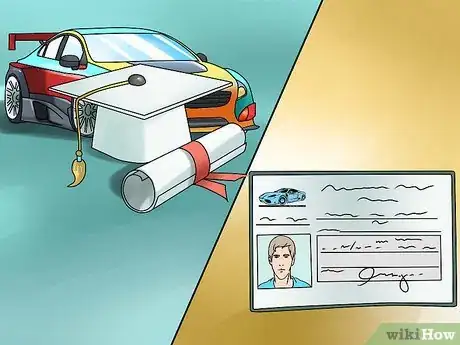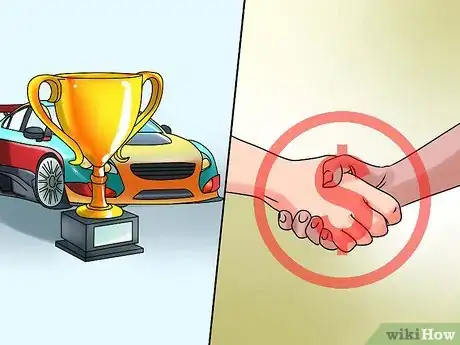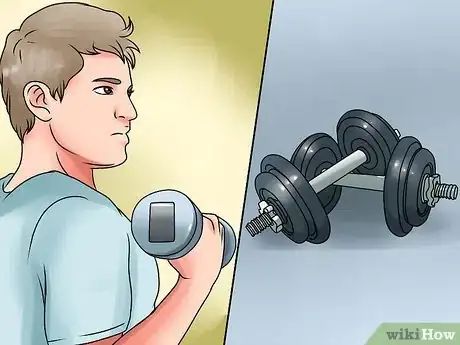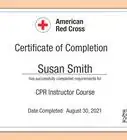wikiHow is a “wiki,” similar to Wikipedia, which means that many of our articles are co-written by multiple authors. To create this article, 25 people, some anonymous, worked to edit and improve it over time.
There are 8 references cited in this article, which can be found at the bottom of the page.
wikiHow marks an article as reader-approved once it receives enough positive feedback. This article received 24 testimonials and 92% of readers who voted found it helpful, earning it our reader-approved status.
This article has been viewed 428,194 times.
Learn more...
With the right focus and training, talented race car drivers can take sensible, measurable steps toward the ultimate goal of driving professionally in the NASCAR circuit. Anyone can aspire toward high-profile professional sports careers, but when it comes to the competitive world of auto racing, a would-be NASCAR driver should first consider gaining some basic experience from which to build a professional driver's resume.
Steps
Starting With the Basics
-
1Race go-karts. Many professional race car drivers started at ages as young as 5 behind the wheel of a go-kart. Karting helps teach you the craft of racing, from control to adapting to the race track for speed.[1] The earlier you start racing, the better your chances will be for cultivating a career later. Learn as much as you can while racing go-karts.
- Enter karting competitions. Different local, national, and international cup competitions are held through the year. Try looking into CIKFIA or The World Karting Association
- If you're not yet of the legal driving age, try to find a track that offers youth racing. This is great way to learn the basics of handling a vehicle around curves while negotiating the pack.
- Race in the soap box derby. The more racing experience you have as a youth, the better equipped you will be for a career in racing.
-
2Graduate to racing actual vehicles. After you have learned all you can from karting, and hopefully gotten a few wins under your belt, start racing cars. Try entering amateur racing competitions. You can also start building a career racing off-road vehicles and motorcycles, like 7x Monster Energy NASCAR Cup Series winner Jimmie Johnson.[2]Advertisement
-
3Compete in local races. Before you can make it to any kind of professional circuit, you need to hone your skills. Race in as many local races as you can. As you win races, you start to build a reputation as you improve your driving skills, enhance your talent, and build a career. Work your way up through local and regional races, collecting as many wins as possible.[3]
-
4Watch professional drivers at work. Watch races on TV. Even better, visit a local track.
- If you have the opportunity to purchase a pit pass, do it, and ask questions of the pit crew members, drivers, managers, and officials.
-
5Study the mechanics of a race car. Find race car mechanics near you or on the Internet, so you can learn everything you can about the mechanics of a race car and how it differs from a passenger car.
- Read textbooks about auto mechanics, or take a course at a local community college. If you are serious about becoming a race car driver, you need to know everything you can about cars, from the basics of a lug wrench to suspensions.[4]
- The most important tool for any race car driver is a reliable car, and although professional drivers have a maintenance staff of mechanics to keep things running smoothly, the driver is the only one on the track who can spot a problem early and pit the car before getting into trouble at high speeds.
-
6Volunteer to help with a local driver's crew. As a volunteer, you’ll generally need some sort of basic skills, such as knowledge of mechanics, though some programs provide training for volunteers. Sometimes, struggling drivers will just be happy for someone to help out, which can lead to you learning skills on site.
- Many amateur and semi-pro teams need volunteers to do all sorts of jobs. This is a good way to meet people and get hands on experience.[5]
-
7Take part in a NASCAR driving course. Most major speedways offer driving experiences that range from ride-along laps to following a pace car, or the ultimate driver's-seat challenge with an experienced passenger to guide you with hand signals as you tour the track.
- “Fantasy” driving schools offer detailed safety and track communications instruction, lessons in standard track procedures, and the opportunity to drive a race car from 3 to 40 laps around the track.
Becoming a Professional
-
1Get an internship at NASCAR. While many race car drivers don't have college educations, working on a degree while racing and honing your skills won't hurt. It's always good to have a degree and career to fall back on in case you don't make it. Plus, racing companies, including NASCAR, offer internships for college students.
- While actual race car experience is important if you want to be a NASCAR driver, it's also important to tune up the mind to deal with the racing business. As the popularity of racing continues to grow and fans continue to pump millions of dollars into the industry, some advanced education in business and communication could give new NASCAR drivers an edge.
-
2Attend a racing school. Different organizations, such as the Sports Car Club of America (SCCA), offer driving schools. An organization such as SCCA can also help you get inside the business as a worker or inspector, which could lead to your own career as a race car driver.[6]
- The Mazda Road to Indy features a driving school, championships, and other opportunities for a career in racing. While not NASCAR, attending something like this could help jumpstart your career.
-
3Get a competition license. Before you get behind the wheel, you will need to apply for a competition license. This can be an arduous process, but different organizations can help you with this process.
- There are slightly different restrictions for people who have racing experience and those who do not. Attending racing schools can help you obtain a competition license.[7]
- Before being awarded a competition license, you will be required to have a physical.
- You will begin with a novice or provisional competition license. After successfully competing in a set number of organization-sponsored races, the driver will be eligible for upgrade to a full competition license.
-
4Don't buy a race car. Race cars are expensive - extremely expensive. And it's not just the race car you have to buy, but everything that goes with it: a trailer, tow truck, and tools.[8] Race a few seasons before you invest in a race car, and make sure you know how to work on it and how to drive it.[9]
-
5Find money. Most race car drivers have said that racing is one of the most expensive sports out there. It takes money to race, either from your own pockets or from sponsors. Factoring in equipment and everything else you need, it can cost tens of thousands of dollars at the beginning of your career to race a season.[10]
- One way to gain sponsors and money is to network. To network, you need to win races. If you are finishing low in a higher division, try racing in a lower division and dominating it. It's more impressive to tell sponsors about your wins than finishing fourth or fifth.[11]
- Spread the word about your success. Get a PR team, even if it's friends or family, and spread the word on social media. Build a website, get a Facebook page, and set up a Twitter account to post about your wins.
-
6Get physically fit and stay fit. Physical fitness is paramount to becoming a successful race car driver. The more trim and healthy a driver, the better equipped he or she will be to withstand the heat, the G-Forces, and body-battering strain of driving at nearly 200 miles per hour (about 322 km/h).[12] Also, race cars can move faster when they carry less weight in the driver's seat. However, don't think this will give you too much of an advantage...as NASCAR puts weights in cars that has a driver lighter than 200 pounds.
Community Q&A
-
QuestionHow do I become a NASCAR driver when I'm a kid?
 Community AnswerTry to find a go-karting place near you or get a golf cart or something to practice on. Then when you can drive real cars you can move up level by level, just like the pros do.
Community AnswerTry to find a go-karting place near you or get a golf cart or something to practice on. Then when you can drive real cars you can move up level by level, just like the pros do. -
QuestionCan I become a Nascar racer if I am from another country?
 Community AnswerYes, there have been a few drivers from other countries, like Juan Pablo Montoya from Columbia, and Daniel Suarez from Mexico.
Community AnswerYes, there have been a few drivers from other countries, like Juan Pablo Montoya from Columbia, and Daniel Suarez from Mexico. -
QuestionCan a female become a NASCAR driver?
 Norberto VelazquezCommunity AnswerThere is nothing to prevent a female from becoming a NASCAR driver.
Norberto VelazquezCommunity AnswerThere is nothing to prevent a female from becoming a NASCAR driver.
References
- ↑ http://www.theguardian.com/money/2014/jun/24/how-become-racing-car-driver
- ↑ http://jimmiejohnson.com/bio
- ↑ http://bleacherreport.com/articles/1641112-5-traits-every-great-nascar-driver-possesses/page/5
- ↑ http://www.automedia.com/So_You_Want_to_be_a_Racecar_Driver/pht20070501rc/1
- ↑ http://www.automedia.com/So_You_Want_to_be_a_Racecar_Driver/pht20070501rc/1
- ↑ http://www.popularmechanics.com/cars/how-to/saturday-mechanic-blog/how-to-race-car-driver
- ↑ https://www.nasaproracing.com/proracing/license.html
- ↑ http://www.automedia.com/So_You_Want_to_be_a_Racecar_Driver/pht20070501rc/1
- ↑ http://www.popularmechanics.com/cars/how-to/saturday-mechanic-blog/how-to-race-car-driver
About This Article
To become a NASCAR driver, get as much racing experience as possible by racing go-karts at your local track and entering go-kart competitions, like the soap box derby. Once you have mastered go-kart racing, enter amateur races and learn about mechanics. If you can, volunteer to work with a local driver's crew. If you can't, take some mechanics courses at your local college. Before you buy a race car, make sure to take driving courses, like those offered through Sports Car Club of America. When you are ready, apply to be an intern at NASCAR. If you want to learn how to get a competition license, keep reading the article!

